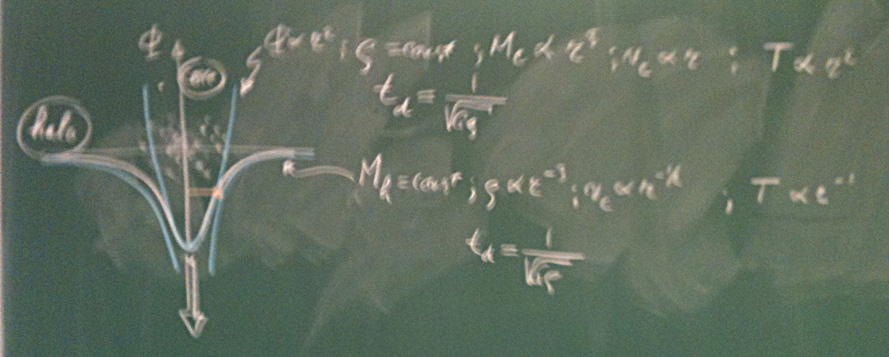
Edition 2012
This course is now closed
A lecture series on the physical processes that govern the structure and evolution of stellar systems.
For first-year Master's students of astronomy and physics.
Lecturer: Vincent Icke
Examination will be in the form of a term paper.
To select a subject for this paper, please contact the lecturer.
Possible absence of the lecturer
11-06-2012
Goal.
The aim of this lecture series is, to provide the student with a basic and robust understanding of the physical processes that govern the structure and evolution of stellar systems such as globular clusters and galaxies. Such systems are definitely not just an application of N-body point mechanics; it will be argued that just about all other astrophysical phenomena play a role in the understanding of large stellar systems. Among these are two- and three-body processes, stellar evolution, tidal effects, and in extreme cases even gravitational radiation.
Means.
This aim is pursued in a series of lectures about the above subjects, with a parallel class of practical exercises. The Teaching Assistant this year is drs. Mattia Fumagalli, whom I thank for his efforts this semester.
Overall Content.
We will discuss stellar dynamics from a theoretical and computational perspective. The dynamics of systems of stars, or other objects that interact gravitationally (dark matter, planets, etc.) are described by Newton's laws of gravity. Exact theoretical analysis generally fails for systems with more than two objects, but for systems with a sufficiently large number of objects new theoretical principles become available. The hardest systems to understand consist of any number of objects between two and 'many'. In this course we start with understanding two objects that orbit each other, to slowly increase the number of objects as we go along. Eventually we focus on approximate approaches to understand the dynamics of stars. Topics include force calculation techniques, integration of the equations of motion, potential theory; orbits in given potentials; the collisionless and the collisional Boltzmann equation; self-gravitating systems; the Jeans equations; dynamical friction, and dynamics of few body systems. Methods are applicable to a wide range of astrophysical systems, such as the Solar system, triple stars, stellar clusters, galaxies, and clusters of galaxies.
The course is aimed at the first-year Master's level. Prerequisites are Classical Mechanics, Ordinary Differential Equations, and a Bachelor's level familiarity with General Astronomy and Stellar Structure and Evolution. It is helpful to have a Bachelor's level knowledge of statistical mechanics and computer programming.
Throughout the course, reference will be made to Prof. Simon Portegies Zwart's lectures on Computational Astrophysics.
Examination.
The examination will probably be in the form of a term paper. Particulars will be announced later.
Format: spoken lecture, 2 hours per week, with accompanying practical class
Examination: term paper
Prior knowledge: classical mechanics, algebra, ordinary differential equations, basic astronomy and astrophysics
Literature: J. Binney & S. Tremaine, "Galactic Dynamics", 2nd Edition, Princeton U. Press
Place and time: Huygens Laboratorium, Room 414
, Mondays 09:00 - 10:45.
Practical exercises: Huygens Laboratorium, Room 414
, Tuesdays 11:00-11:45, taught by drs. Mattia Fumagalli
Credits: 6 ECTS
Course schedule: the most recent version of the course schedule is to be found here.
Language
As required by the regulations of Universiteit Leiden, these lectures will be given in English.
Contents
The following chapters and sections of the book by Binney & Tremaine will be covered (cf. the 'Recommended Course' on p.xiv of the book):
1.1, 1.2
2.1, 2.2, 2.3, 2.9
3.1, 3.2, 3.4 (3.7 is recommended reading)
4.1, 4.3, 4.7, 4.8, 4.9 (4.10 is recommended reading)
7.1, 7.2, 7.3, 7.5
8.1, 8.3, 8.5
Possibly 5.1 and 6.1 will be adressed later, time permitting. Others will occasionally be referenced but are not part of the main stream of the lectures; these focus on general stellar-dynamics processes and only incidentally refer to the detailed structure of galaxies. Student requests for having other topics highlighted will be considered very seriously and granted where time permits.
Supporting Literature:
W.C. Saslaw, "Gravitational physics of stellar and galactic systems", Cambridge UP, 1987
D. Heggie & P. Hut, "The gravitational million-body problem", Cambridge UP, 2003
A.E. Roy, "Orbital Motion", Adam Hilger, 2nd Ed., 1982
Incidental Notes

Vrije weglengte
Speciale Relativiteitstheorie


Notes leading up to the Jeans Equations
MP3 audio recordings of the lectures.
These will be placed here as soon as possible after the lectures.
They are presented 'as is'. Remarks and corrections are welcomed by the lecturer.



